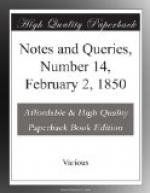“I wyll edefy more, with the syght of it Than wyll all the pratynge of holy wryt; For that except that the precher, hym selfe lyue well, His predycacyon wyll helpe neuer a dell, And I know well, that thy lyuynge is nought: Thou art an apostata, yf it were well sought, An homycyde thou art I know well inoughe,” &c.
The line omitted is the more remarkable, because it contains an instance of the employment of a word very old in our language, and in use in the best periods of our prose and poetry: “apostata” is explained in the Promptorium, is found in Skelton and Heywood, and so down to the time of Massinger, who was especially fond of it.
How many copies were issued of Smeeton’s reprint of The Pardoner and the Frere, I know not; but any of your readers, who chance to possess it, will do well to add the absent line in the margin, so that the mistake may be both rectified and recorded. I was not aware of Mr. Child’s intention to re-publish the interlude in the United States, or I would long ago have sent him the correction, as indeed I did, a day or two after I received his volume. It was, nevertheless, somewhat ungracious to thank him for his book, and at the same time to point out an important error in it, for which, however, he was in no way responsible.
J. Payne Collier.
Kensington, Jan. 28. 1850.
* * * * *
Catacombs and Bone-houses.
Without attempting to answer the queries of Mr. GATTY, (No. 11. p. 171.) I venture to send a note on the subject. I believe it will generally be found that the local tradition makes such collections of bones to be “the grisly gleanings of some battlefield.” One of the most noteworthy collections of this kind that I have seen is contained in the crypt of Hythe Church, Kent, where a vast quantity of bones are piled up with great regularity, and preserved with much care. According to a written statement suspended in the crypt, they are the relics of Britons and Saxons slain in a battle fought on the beach in the sixth century; the local tradition is nearly to the same effect, but of course is of little value, as it has most likely arisen from or been conformed to this “written chronicle;” both writing and tradition must indeed be regarded with distrust. It is affirmed in the neighbourhood that the bones were dug up from the beach; but I, at least, could hear of no tradition as to the period when they were exhumed. Perhaps some resident will ascertain whether any such exists.
The bones have all the appearance of considerable antiquity; yet they are in excellent preservation. The skulls are remarkably white and perfect, and are altogether a very curious collection, differing greatly in size, form, and thickness. The holes and fractures in many of them (made evidently during life) leave no doubt that they belonged to persons who met with a violent death.




